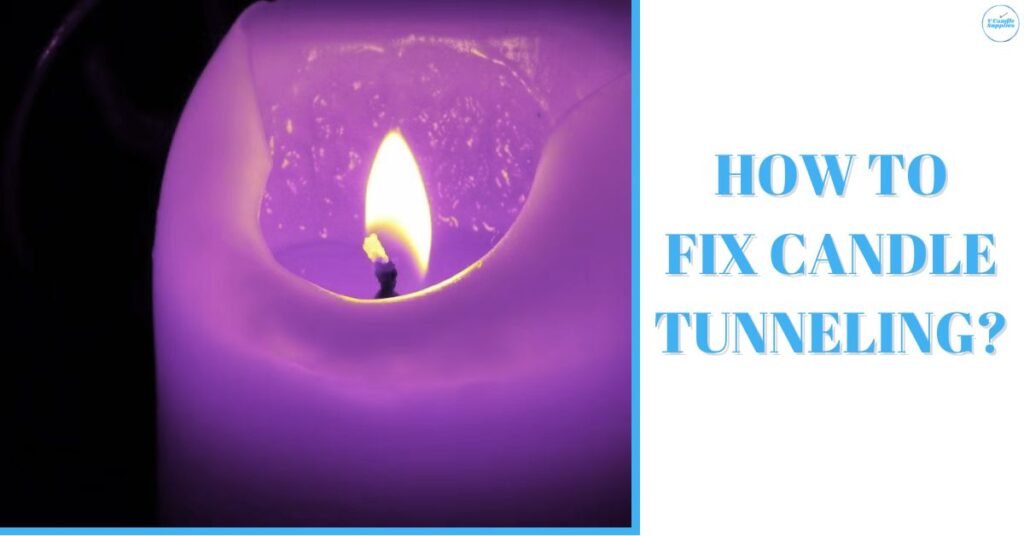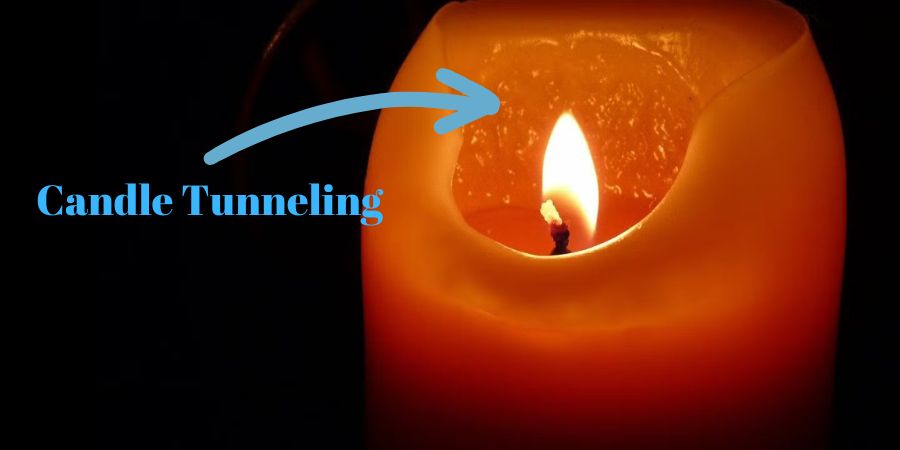COD available for orders below 1500. Shipping Charges will be added at the end while placing the order. Happy Candle Making :)
Candle Tunneling: What Cause and How to Fix? [4 Method]

Candle tunneling, a frequent issue among candle makers, significantly diminishes the enjoyment and lifespan of your candles. This phenomenon occurs when only a narrow ring of wax near the wick is consumed, leaving a stubborn ring of unused wax clinging to the container’s sides.
While this frustrating occurrence is more prevalent in lower-quality candles, it’s not exclusive to them; even the most luxurious candles can fall victim to tunneling. Often, this problem arises from a mismatch between the wick size and the candle, or from insufficient burning during the initial use. Neglecting the first burn’s duration sets the stage for a less than optimal burning experience.
Understanding the nuances of candle tunneling is crucial for anyone looking to enhance their candle-burning experience. Whether you’re a seasoned candle lover or new to the world of aromatic waxes, this guide is tailored for you.
What is Candle Tunneling?

Candle tunneling is a common issue faced by homemade candle makers. It occurs when a candle burns down the middle, forming a tunnel-like hole, rather than melting evenly across the entire surface. This results in a ring of unburned wax along the sides of the container, leading to wax waste and potentially making it difficult to light the wick over time.
In homemade candles, tunneling is often due to a mismatch between the wick size and the candle’s diameter. A wick that’s too small for the container can’t generate enough heat to melt the wax evenly, leading to tunneling. Additionally, the initial burn time plays a crucial role. If a candle isn’t allowed to melt across its entire surface the first time it’s lit, tunneling may occur in subsequent burns.
Causes of Candle Tunneling
Poor Candle Burning Habits
- Insufficient Initial Burn: One of the primary causes of candle tunneling is not allowing the candle to burn long enough during its first use. The initial burn is crucial as it sets the ‘memory’ for the wax. If the wax doesn’t melt to the edges of the container on the first burn, it’s likely to continue burning narrowly, leading to tunneling.
- Frequent Short Burns: Regularly burning a candle for short periods can also contribute to tunneling, as the wax doesn’t get enough time to melt evenly across the surface.
Improperly Sized Wicks
- Wick Too Small: If the wick is too small for the candle’s size, it won’t generate sufficient heat to melt the wax all the way to the edges of the container. This mismatch often results in a narrow melt pool and subsequent tunneling.
- Quality of Wick: Besides size, the quality of the wick also plays a role. Poor quality or improperly constructed wicks may not burn efficiently, contributing to uneven melting.
Why is Candle Tunneling Bad?
Candle tunneling is not just a visual issue; it has practical implications as well:
- Wax Waste: The most apparent problem with tunneling is the wastage of wax. The unmelted wax on the sides remains unused, reducing the candle’s lifespan.
- Diminished Scent Throw: For scented candles, tunneling can lead to a weaker scent throw. As the wax on the sides doesn’t melt, the fragrance oils in that wax don’t get released into the air.
- Difficult to Light: As the wick gets deeper into the tunnel, it becomes harder to light and maintain the flame, eventually rendering the candle unusable.
- Safety Concerns: In severe cases, tunneling can lead to safety issues, such as an uneven burn leading to a higher risk of the flame catching onto something outside the candle.
How to Prevent Candle Tunneling
Preventing candle tunneling is key to maximizing the lifespan and enjoyment of your candles. By understanding and implementing a few crucial steps, you can ensure that your candles burn evenly and efficiently.
Candle Tunneling on First Burn
- Setting the Memory: The first burn of a candle is critical in setting the ‘memory’ of the wax. It’s essential to allow the candle to burn long enough so that the entire top layer of wax melts and reaches the edges of the container. This usually takes about one hour for every inch of the candle’s diameter.
- Avoiding Early Extinguishing: Extinguishing the candle too early on its first burn can lead to tunneling in subsequent burns. Ensure the entire surface has melted to prevent this.
Selecting the Right Wick Size
- Matching Wick to Candle Size: The size of the wick should be appropriate for the size of the candle. A wick that’s too small won’t produce enough heat to melt the wax to the edges, leading to tunneling.
- Quality of Wick: High-quality wicks are crucial for an even burn. They should be centered and sturdy enough to stand upright as the wax melts around them.
Draft-Free Environment
- Avoiding Drafts: Burning candles in a draft-free environment is essential. Drafts can cause the flame to flicker and burn unevenly, contributing to tunneling.
- Stable Temperature: Keeping the candle in a room with a stable temperature helps in achieving an even burn.
Candle Types and Their Impact
- Homemade Candle Tunneling: For homemade candles, ensuring the right wick size and wax type is crucial. Experimentation might be necessary to find the perfect balance.
- Three Wick Candle Tunneling: Candles with multiple wicks, like three-wick candles, need all wicks to be lit simultaneously to ensure an even melt pool. This prevents tunneling and ensures that all the wax is utilized.
How to Fix Candle Tunneling
Even with the best care, candles can sometimes develop tunneling. Fortunately, there are several effective methods to fix this issue and salvage your candle. Here are some of the most popular techniques:
The Aluminum Foil Method
- Procedure: Wrap a piece of aluminum foil around the top of the candle, leaving a small hole in the center for the flame. This creates a makeshift oven that reflects heat back onto the sides of the candle, melting the excess wax.
- Duration: Let the candle burn for a few hours with the foil on. Check periodically to see if the wax has melted evenly.
- Benefits: This method is simple and uses a common household item. It’s particularly effective for mild to moderate tunneling.
The Hair Dryer Method
- Procedure: Use a hair dryer on a low setting to evenly heat the top surface of the candle, focusing on the areas with unmelted wax.
- Safety: Keep the hair dryer at a safe distance to prevent hot wax from splattering.
- Benefits: This method is quick and effective, especially for candles with a shallow amount of tunneling.
Using a Microwave
- Procedure: Remove any metal parts from the candle and place it in the microwave. Heat in short intervals (about 10-15 seconds), checking after each interval until the top layer of wax has melted evenly.
- Caution: This method is not suitable for candles in metal containers or with metal wicks. Always monitor the candle closely while in the microwave to prevent overheating.
The Oven Method
- Procedure: Preheat your oven to a low temperature (around 175°F). Place the candle on a baking sheet and put it in the oven. Watch closely as the wax melts evenly.
- Duration: It may take around 5-15 minutes, depending on the size of the candle and the depth of the tunnel.
- Benefits: This method is effective for severe tunneling and can evenly melt a large amount of wax.
Each of these methods can be effective in fixing candle tunneling, but it’s important to choose the right one based on the severity of the tunneling and the type of candle you have. Always prioritize safety, especially when dealing with heat and open flames.
Special Cases in Fixing Candle Tunneling
Candle tunneling can present unique challenges in certain types of candles. Understanding how to address these specific cases can help in effectively fixing the tunneling issue.
Fixing Tunneling in Homemade Candles
-
-
Understanding Wax Types
-
Homemade candles might use a variety of waxes, each with different melting points and characteristics. Be aware of the type of wax you used, as this will influence how you fix the tunneling.
-
-
Re-melting and Resetting
-
For severe tunneling, consider gently melting the top layer of the candle using a double boiler method, then allowing it to cool and reset. This can level out the wax surface.
-
-
Wick Adjustment
-
If the wick is improperly sized, you may need to replace it. This involves melting the wax, removing the old wick, and setting a new, appropriately sized wick.
Fix 3 Wick Candle Tunneling
-
-
Even Burning
-
Ensure all wicks are lit at the same time and burn for a sufficient duration to allow an even melt pool across the entire surface.
-
-
Foil Method Adaptation
-
Use the aluminum foil method, ensuring the heat is evenly distributed across all three wicks. This might require a larger opening in the foil to accommodate all flames.
-
-
Regular Wick Trimming
-
Keep all three wicks trimmed to the same length to promote an even burn.
Fix Tunneling Candle with Short Wick
-
-
Exposing the Wick
-
If the wick has become too short, carefully remove some of the excess wax around the wick using a tool like a butter knife or spoon. This exposes more of the wick for easier lighting.
-
-
Gentle Heat Application
-
Use a hair dryer or heat gun to melt some of the surrounding wax, allowing the wick to become more accessible.
-
-
Wick Replacement
-
In cases where the wick is too short to salvage, consider replacing it. Melt the wax, remove the old wick, and insert a new one, ensuring it’s properly centered and secured.
Conclusion
Understanding and addressing candle tunneling is not just about preserving the aesthetic appeal of your candles; it’s a crucial practice for enhancing their longevity, efficiency, and overall burning experience. Tunneling, if left unchecked, leads to wax wastage, diminished scent throw, and potentially shorter candle life. By implementing the preventive measures and fixing techniques discussed, you can significantly improve the performance of your candles, whether they are store-bought, homemade, single or multi-wick.




